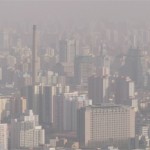NO2, also known as nitrogen peroxide, is a reddish-brown gas at room temperature and has numerous industrial applications, such as serving as a nitrating agent for explosives and as an oxidizing agent in rocket propulsion.15 Potential occupation exposures to NO2 include fuel combustion in motor vehicles and stationary power plants, etching of metal with nitric acid, as well as acetylene and electric cutting and welding.15 In agricultural settings, fermentation of recently stored agricultural silage can also produce NO2. Motor vehicle traffic is a common source of NO2 exposure in the general population, and indoor sources include poorly vented gas ranges, and kerosene or gas space heaters.15 NO2 is readily absorbed and nearly all inhaled compound is absorbed through the tracheo-bronchial tree.12,15
Less frequently assessed are exposures to black carbon and carbon monoxide (CO), both produced by the incomplete combustion of hydrocarbon materials, such as during the operation of internal combustion engines.16,17
Ozone is also a pollutant, produced when nitrogen oxides (NOx) and volatile organic compounds (VOCs) interact under the action of sunlight.18 NOx are also generated by fossil fuel combustion, such as from motor vehicle engines; power plants; industrial plants; and boilers; VOC sources are motor vehicle emissions, gasoline vapors and chemical solvents.18 Ozone creation, destruction and dispersion are highly dependent on temperature, wind speed and direction, solar radiation and humidity.18 High concentrations of ozone are observed over large cities and metropolitan areas during warm months.18
Measuring Air Pollution Exposure in Research Studies
Most metropolitan cities have dedicated automated fixed-site continuous monitoring stations that collect hourly mean levels of criteria air pollutants (i.e., O3, NO2, SO2, CO, PM10 and PM2.5). The hourly data can be averaged to obtain daily estimates for the entire city and provide air pollution data for temporal analyses; however, these estimates are often not precise across geographic regions.
Air pollution is a recognized risk factor for respiratory & cardiovascular disease, but has also been associated with immune-mediated diseases, such as inflammatory bowel disease & multiple sclerosis.
Land-use regression (LUR) or inverse density weighting is applied to estimate pollution exposure at a given geographical point, typically an individual’s location of residence (determined by postal code). LUR models use Geographic Information System (GIS) to estimate air pollutant exposure through a combination of land use, traffic, population density, physical geography and meteorology across an area and predict concentrations at a defined site.19,20
Inverse distance weighting uses the general principle of interpolation, where values of a given variable are estimated and derived from a known and measured value at another point (e.g., a monitoring station), and sources farther from the reference point will have a lower impact of the pollution.21


